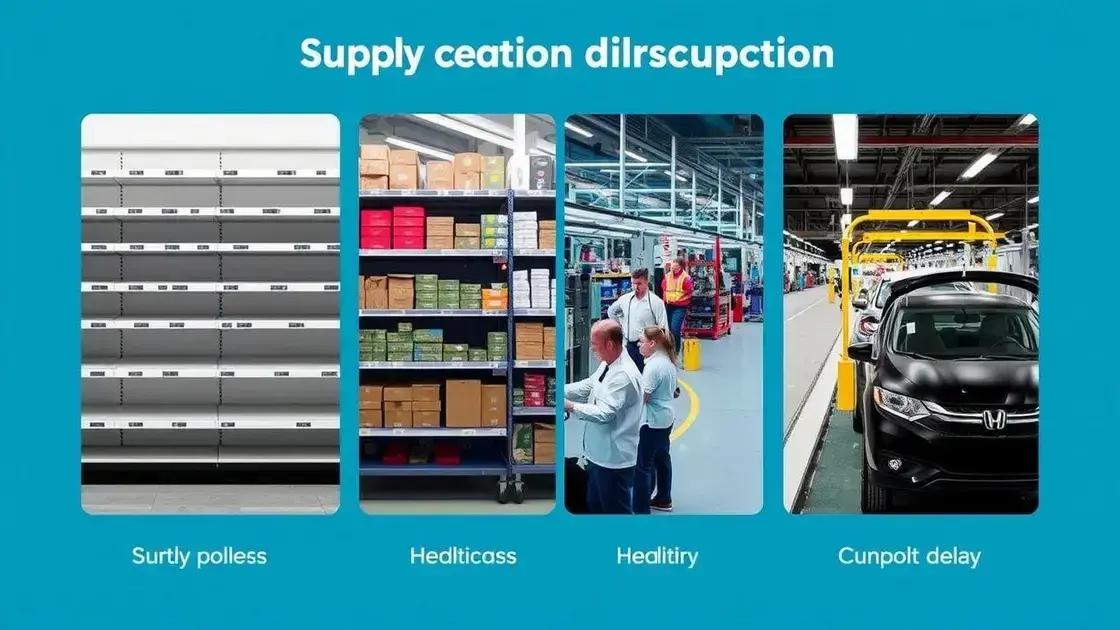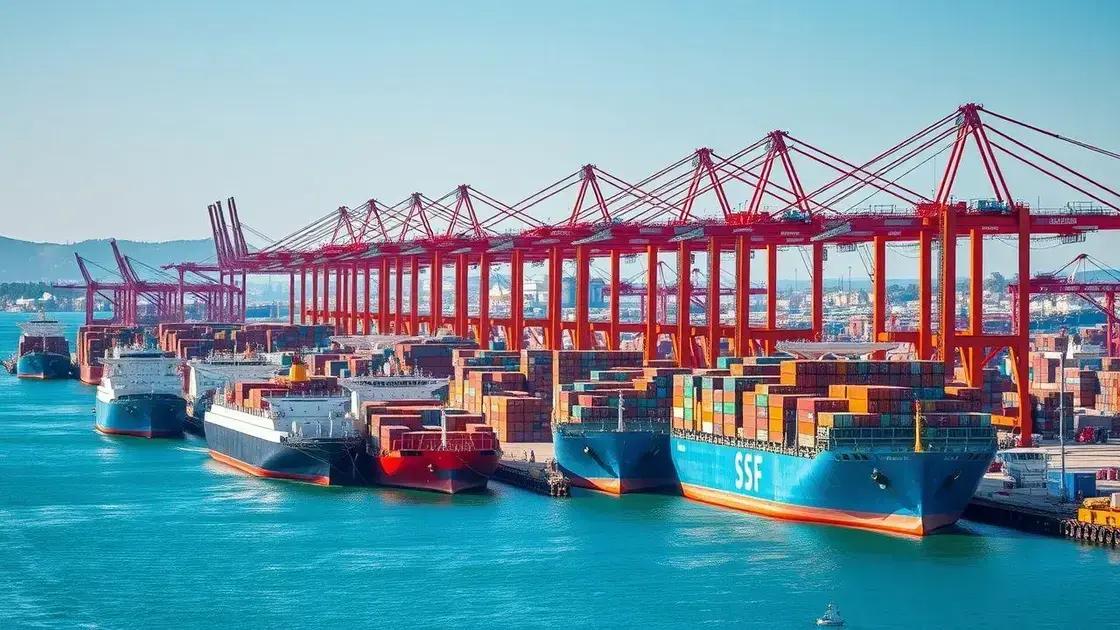Global supply chain disruptions updates: what you need to know

Anúncios
Global supply chain disruptions arise from factors like globalization, labor shortages, and natural disasters, significantly affecting industries by causing delays and shortages, necessitating strategic responses for resilience and stability.
Global supply chain disruptions updates are essential for anyone trying to navigate today’s complex market landscape. As industries face varying challenges, understanding these shifts can help businesses adapt and thrive. What trends are reshaping the world of trade? Let’s dive in.
Anúncios
Current state of global supply chain disruptions
The current state of global supply chain disruptions is a topic that affects businesses worldwide. Understanding these disruptions is critical for adapting strategies and ensuring smooth operations.
Several factors contribute to ongoing challenges in the supply chain. These include labor shortages, geopolitical tensions, and natural disasters. Each of these factors plays a significant role in the accessibility of raw materials and the delivery of products.
Anúncios
Key Factors Impacting Supply Chains
To grasp the situation better, it’s essential to recognize the primary reasons behind these disruptions:
- Labor shortages have led to reduced production capabilities, delaying shipment times.
- Geopolitical tensions can create unpredictable barriers in trade, forcing companies to rethink their logistics.
- Natural disasters can significantly impact transport routes and production facilities, putting additional strain on supply chains.
Moreover, the current global pandemic has accelerated many of these issues. An increasing demand for goods combined with slow recovery rates has led to a bottleneck effect. Businesses are now facing higher shipping costs and extended delivery times, which in turn affect consumer satisfaction.
While adapting to the challenges is crucial, companies must also stay informed about ongoing market shifts. Understanding emerging risks allows businesses to create more resilient strategies and mitigate potential impacts on their operations.
In addition, technology plays a vital role in navigating these disruptions. Utilizing data analytics and supply chain management software can provide insights into supply trends, helping businesses make informed decisions.
Major causes affecting supply chains today
Understanding the major causes affecting supply chains today is key to mitigating risks and developing effective strategies. Various factors contribute to the complexities that businesses face in this ever-changing landscape.
One significant cause is the rise of globalization. As markets expand, supply chains become more intricate, involving multiple countries and stakeholders. This adds layers of risk, making it essential for companies to understand international relations and trade agreements.
Key Factors in Supply Chain Disruptions
Several additional factors can heavily impact supply chains:
- Natural disasters can disrupt logistics and halt production.
- Cybersecurity threats raise concerns, as attacks can compromise sensitive data and operational efficiency.
- Regulatory changes may create sudden compliance requirements, impacting costs and timelines.
Furthermore, the ongoing COVID-19 pandemic has highlighted vulnerabilities within supply chains. Lockdowns and restrictions led to significant delays and shortages, prompting businesses to reevaluate their strategies. Adapting to these changes is crucial for future success.
The demand for certain products can fluctuate unexpectedly, leading to inventory challenges. Companies must anticipate these changes to avoid stockouts or surplus inventory. This requires ongoing analysis and forecasting.
Diverse sourcing strategies are becoming increasingly popular, as businesses look to reduce dependence on a single supplier. By spreading their risk across multiple sources, they enhance their resilience against disruptions.
Impact on different industries

The impact on different industries due to supply chain disruptions is significant and varies widely. Each sector faces unique challenges that affect its operations and bottom line.
The manufacturing industry, for instance, has seen delays in getting raw materials. This slowdown can halt production lines, resulting in decreased output. Many manufacturers are now reassessing their supply sources and looking for local alternatives to reduce reliance on long-distance shipping.
Effects on Key Sectors
Other sectors are also experiencing profound impacts:
- Retail has had to adjust inventory levels dramatically, leading to empty shelves and dissatisfied customers.
- Healthcare is facing shortages of critical medical supplies and equipment, which can directly affect patient care.
- Food and Agriculture are dealing with disruptions in supply chains that impact the freshness and availability of products.
Additionally, the automotive industry is struggling with a shortage of essential components, like chips, delaying vehicle production. These delays not only impact the manufacturers but also the dealers and consumers waiting for new vehicles.
The technology sector faces similar challenges, as reliance on international suppliers for hardware has led to longer wait times for new devices and equipment. Companies are exploring ways to localize their supply chains, aiming to mitigate risks associated with global dependencies.
Understanding these impacts helps businesses strategize for the future, ensuring they can navigate the challenges posed by ongoing supply chain disruptions.
Strategies businesses can employ
To navigate supply chain disruptions effectively, businesses can adopt various strategies that enhance resilience and adaptability. These strategies help organizations mitigate risks and maintain a steady flow of operations.
One effective approach is to diversify supply sources. By not relying on a single supplier, businesses can reduce the impact of disruptions affecting one particular source. This strategy encourages companies to seek local suppliers and build relationships with multiple vendors.
Key Strategies for Resilience
Implementing technology solutions is another crucial strategy. Modern supply chain management software enables real-time tracking and forecasting, allowing businesses to respond quickly to changes. Companies can monitor inventory levels and adjust orders based on demand.
- Supply chain mapping helps identify weaknesses in the network and provides insights on potential vulnerabilities.
- Just-in-time (JIT) inventory can reduce storage costs and improve efficiency, although it requires precise supplier reliability.
- Building strong relationships with suppliers promotes better communication, leading to quicker resolutions during disruptions.
In addition to these methods, companies should consider scenarios and develop contingency plans. By preparing for various outcomes, businesses can minimize downtime and maintain service levels regardless of challenges.
Finally, continuous education and training for employees are vital. Keeping staff informed about potential risks and the latest industry trends can empower them to make informed decisions. This approach contributes to a more agile and prepared workforce.
Future predictions for supply chain stability
Future predictions for supply chain stability are vital for businesses looking to navigate upcoming challenges. Experts believe that while the landscape may continue to face disruptions, there are actionable steps companies can take to improve resilience.
One prediction is that digital transformation will play an even greater role in optimizing supply chains. Companies will increasingly rely on data analytics and artificial intelligence to enhance decision-making processes. This shift can lead to more accurate demand forecasting and improved inventory management.
Emerging Trends Impacting Stability
Several trends are expected to influence the future stability of supply chains:
- The adoption of blockchain technology to enhance transparency and traceability throughout the supply chain.
- Increased emphasis on sustainability, with businesses prioritizing eco-friendly practices, which may alter supply sources.
- A rise in nearshoring as companies seek to reduce reliance on distant suppliers, bringing production closer to home.
Furthermore, organizations are likely to invest in building more agile supply chains. This means developing flexible logistics networks that can adapt to changes quickly, whether due to sudden market shifts or environmental factors.
As companies prepare for future uncertainties, the importance of collaboration across the supply chain cannot be overstated. Partnerships among suppliers, manufacturers, and retailers are essential for sharing information and resources effectively.
Finally, a focus on human factors, including employee training and workforce adaptability, will ensure that enterprises are equipped to handle future challenges. A well-prepared workforce can significantly contribute to overall supply chain stability.
In summary, the **global supply chain disruptions** are reshaping industries and forcing businesses to adapt. Understanding the causes, impacts, and potential strategies is crucial for future resilience. With technology playing a key role, companies can leverage data and strengthen their networks. Collaborating with suppliers and investing in talent will also help navigate challenges. By being proactive, businesses can enhance stability and prepare for the future. Here’s a brief overview of the main points discussed:
FAQ – Frequently Asked Questions about Global Supply Chain Disruptions
What are the main causes of supply chain disruptions?
The main causes include globalization, labor shortages, natural disasters, and geopolitical tensions.
How do supply chain disruptions impact industries?
Industries face challenges like manufacturing delays, retail shortages, and healthcare supply issues due to disruptions.
What strategies can businesses employ to mitigate supply chain issues?
Businesses can diversify their suppliers, invest in technology, and build strong relationships with partners.
What role does technology play in supply chain management?
Technology helps businesses use data analytics for better forecasting and enhances operational efficiency in the supply chain.






